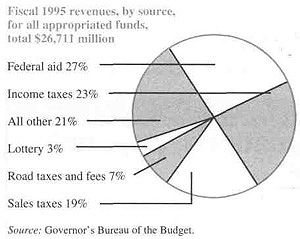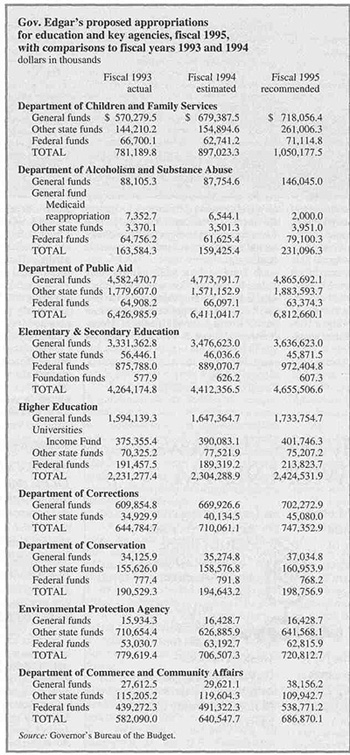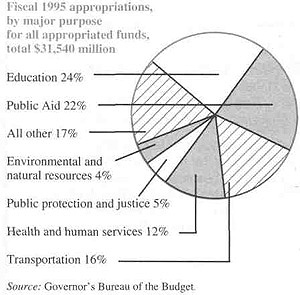 |
Home | Search | Browse | About IPO | Staff | Links |
The state of the State

|
Edgar 's budget filled |
When even your political enemies can offer up only lukewarm criticism of your biggest public project for the year, you know you must have done something right — at least on the surface.
That may have been how Gov. Jim Edgar felt after delivering his state budget message in early March. Even some of his expected detractors acknowledged there were things they liked in the proposed budget for fiscal year 1995, such as an $86.4 million funding increase for colleges and universities, and the proposed opening of 2,244 new prison beds.
But foes and friends alike could be singing a much different tune should any of the conditions upon which the budget is built fall through. The $31.54 billion spending plan hinges on several levels of approval that the gover-nor's Medicaid reform proposal must go through — from federal waivers to legislative approval to an ability to refinance state debt and spend the savings on unpaid Medicaid bills. (See pages 18-22.)
As Edgar pointed out, schools will bear the brunt of any failure along the way. "There will be massive cuts in education," he warned, should the Medicaid reforms go belly-up. Not only would his recommended increase of $246 million for elementary, secondary and higher education have to go out the window, but hundreds of millions of dollars of the overall money earmarked for education would have to be cut as well.

|
Why would classrooms have to bear so much of the financial slicing that may become necessary? "There's no court order telling us what to do in education," the governor said. Court-ordered reforms in the state's Department of Children and Family Services (DCFS) and Departmentof Mental Health and Developmental Disabilities account in part for Edgar's proposed billion-dollar-plus appropriations to each of those two agencies. One reason the budget is so reliant on the debt refinancing scheme is that Edgar chose to spend all of the $600-plus million of state revenue growth on new things, instead of using any of it to help pay the state's backlog of unpaid Medic-aid bills. In doing so, his budget plan is able to call for: • A $1.05 billion proposal for DCFS, $71 million of which would come from federal funds. In part, the money would provide for the hiring of about 200 new employees, most of whom would be caseworkers to keep caseload ratios down. The department's budget also would include $1.8 million to provide transitional care for children just removed from their families. The money would help set up centers for such care in empty space at public housing projects in Chicago. Details of the proposal were not released with the budget message, but the general wisdom of such a plan has been questioned by those who believe existing problems at trouble-plagued housing projects should be solved before children whose lives are in crisis are added to the mix. DCFS also would receive $1.2 million for fingerprinting foster parents, adoptive parents and relatives who care for children in state custody; an additional $114,000 would be spent on the necessary equipment. This would not free up money and time from the State Police, who cur- |
8/April 1994/Illinois Issues
rently conduct such fingerprinting; rather, it would enable DCFS to help clear up the backlog of people who still have not been fingerprinted.
• A $1.079 billion allocation to the mental health department, $30 million of which would be federal funds. It is broken down into $511 million recommended for mental health services and $567 million for developmental disabilities services. This money will include a 3.3 percent cost-of-living adjustment for community service providers, effective in April 1995.
A reorganization of services for children and adolescents in the Chicago area is planned. This would include closing the Henry Horner Children's Center, where 100 staff positions would be closed. Bureau of the Budget Director Joan Walters said these
• A $6.8 billion appropriation to the Department of Public Aid, the bulk of which would be $5 billion for Medicaid. Following up on the Teen Parent Initiative announced in his January State of the State speech, Edgar proposed that teenage mothers 18 and under be required to attend
high school and earn their diplomas or high school equivalency degrees to retain welfare benefits.
Doug Dobmeyer, executive director of the Public Welfare Coalition, said encouraging young mothers to complete their education is a good idea. But he added that punishing those who do not by canceling their Aid to Families with Dependent Children (AFDC) money would only harm their babies, thereby amounting to "counter-productive public policy."
Dobmeyer went on to point out that the number of people receiving public aid increased by more than 9 percent over the past year, but that the governor's budget would cut assistance programs for those who don't qualify for AFDC. The State Family and Children Assistance Program for needy families would be halved, from $17.4 million to $8.7 million, and Transitional Assistance for single adults would be cut from $42.3 million to $27.9 million.
• $231.1 million for the Department of Alcoholism and Substance Abuse, which includes $9 million for unpaid provider bills from fiscal year 1993 and $17.8 million in such bills for this fiscal year. Expanded treatment for substance-abusing parents whose children may be at risk of abuse or neglect is included, budgeted at $13.4 million. And $21.3 million is earmarked for preventive efforts, including a new gang and violence prevention program in six urban areas.
• An $86.4 million
April 1994/Illinois Issues/9
In his March budget message, Gov. Jim Edgar gave a nod to those worried about how much money the state will owe to public employees when they retire.
Last year, the state's auditor general reported that Illinois has promised $14.1 billion more in pension benefits to employees than it has in the bank. Because these benefits are guaranteed to retirees by the state Constitution, some lawmakers began speculating that if nothing is done start saving toward this obligation, taxpayers eventually may face an income tax increase devoted solely to the state pension systems.
So Edgar is pushing a reconfiguration of a plan originally touted by state Comptroller Dawn dark Netsch when she was in the state Senate. Edgar's plan would meet the pension systems' shortfall over the next 50 years. His budget proposes a $9 million increase in pension funding for fiscal year 1995 — but the more painful funding steps wouldn't begin until the following fiscal year, when an additional $80 million would have to be pumped into the systems.
Pushing the larger obligation off a year allows Edgar to advocate spending in other, more popular areas such as education.
Edgar repeatedly has blamed the state's current fiscal woes on policies of his predecessor's administration that in general pushed off funding financial obligations (not that this criticism has kept him from tapping former Gov. James R. Thompson's top aides as his own). Obviously this policy of delay is one temptation Edgar doesn't mind sampling
Jennifer Halperin
increase for the state's public colleges and universities, including a 3.5 percent salary increase and $30.1 million more for the Monetary Award Program, which provides assistance to needy students. This funding level would raise the maximum awards by $300, to $3,800 from $3,500.
• A $747 million Department of Corrections budget that would open a total of 2,244 new prison beds, including a 100-bed housing unit at the Kankakee women's facility and cellhouses to be built at the Sheridan, Western Illinois and Illinois River correctional centers. It also includes $6 million in capital funds for a juvenile boot camp.
• Funding in a $233 million State Police budget for 55 new officers scheduled to begin training this June — the first cadet class of state police officers in four years. Coming on the heels of House Speaker Michael J. Madigan's call for $200 million in revenue growth to be used to hire 6,600 new local police officers in Illinois, Edgar's proposal may have sounded relatively paltry to some, giving Madigan fodder to use in trying to make Edgar sound weak on crime.
Of course, many elements of the budget likely will have to be revamped if the governor's proposed Medicaid reform plan does not work out — unless he has an unlikely change of heart on a tax hike.
A study by the League of Women Voters of Illinois found that a graduated income tax similar to those used in 34 other states would have generated $1.1 billion in additional money if applied back in 1989 — and substantially more, no doubt, if applied now. That's an awfully tempting figure, especially when the state is looking for ways to pay medical bills due to hospitals and physicians who provided health care to poor people.
But that's a temptation Edgar almost definitely will be able to resist. It just doesn't have the flavor suitable for pre-November.
10/April 1994/Illinois Issues

positions likely would be transferred to other facilities or closed through attrition. Patients at Henry Horner and St. Anne's Hospital would be relocated to the renovated Illinois State Psychiatric Institute in Chicago.
Pensions funding: Another promise to resolve unfunded
future benefits Another promise to resolve unfunded future benefits
|
Sam S. Manivong, Illinois Periodicals Online Coordinator |
